3D CFD Simulation of Phase Resonance in a Pump Turbine with an Acoustic Model
Abstract
1. Introduction
2. Simulation Configuration
2.1. Computational Domain and Mesh
2.2. Compressibility Function
2.3. Boundary Conditions and Solver Control
2.4. Simulated Load Case
2.5. Monitoring Points
3. Simulation Results
3.1. Appropriate Timestep Δt to Capture the PR Phenomenon Inside the Spiral Casing
3.2. The influence of the Sound Speed a0
- (1)
- (2)
- On the other hand, by comparing a0 = 1320 m/s in Figure 8b and a0 = 1450 m/s in Figure 9 with a0 = 1200 m/s in Figure 6d, we can observe that increasing the sound speed a0 leads to the pressure waves traveling out of the spiral case faster, so the amplitudes along the spiral case would increase or be about constant over the spiral circumference. When the sound speed was increased, in our case, the ratio Lsp/(2λ) was closer to 1.0.
- (3)
- The comparison of the phases revealed that the phase differences between various monitoring points and SP_00 are all almost linear along the distance that pressure waves travel out of the spiral casing of all four sound speeds. In adding a phase lag due to the distance between monitoring points, Figure 11 presents the phase differences among all the monitoring points of the spiral circumferences for the case of a0 = 1200 m/s. It can be seen that the pressure fluctuations of all the monitoring points in the spiral casing have almost the same phase, and this is the so-called direct PR. In the Supplementary material, an animation of the PR phenomenon is provided from this study for the case of a0 = 1200 m/s.
4. Discussions
4.1. Direct PR and Indirect PR
4.2. Risk Factor RF
4.3. Influence of the RSI
4.4. Influence on the RSI
5. Conclusions
- (1)
- To capture the PR phenomenon inside the spiral casing due to blade passage, an appropriate timestep of Δt = 1/32 or 1/40 bpt is recommended.
- (2)
- A certain kind of direct PR risk was detected inside the pump turbine and studied through a 3D CFD simulation with an acoustic model.
- (3)
- The detected direct PR differed from the well-known PR with two features: firstly, it was almost independent of the sound speeds; secondly, the pressure distribution over the spiral circumference was not uniform and varied in amplitude.
- (4)
- The uneven pressure amplitude distribution resulted from the pressure waves at every stator channel induced by the RSI, which is normally neglected in the standard 1D analysis. As the RSI and PR are not independent, a 3D CFD simulation with an acoustic model, which couples the RSI and PR phenomena, could better predict the results to understand the problem compared to the 1D method.
Supplementary Materials
Author Contributions
Funding
Institutional Review Board Statement
Informed Consent Statement
Data Availability Statement
Acknowledgments
Conflicts of Interest
References
- Haban, V.; Koutnik, J.; Pochyly, F. 1-D Mathematical model of high-frequency pressure oscillations induced by RSI including an influence of fluid second viscosity. In Proceedings of the 21st IAHR Symposium, Lausanne, Switzerland, 9–12 September 2002; pp. 735–740. [Google Scholar]
- Christophe, N. Hydroacoustic Modelling and Numerical Simulation of Unsteady Operation of Hydroelectric Systems [D]. EPFL Thesis No. 3751, Ph.D. Thesis, Ecole Polytechnique Fédérale, Lausanne, Switzerland, 2007. [Google Scholar]
- Alireza, Z. Investigations of Time Dependent Flow Phenomena in a Turbine and a Pump-Turbine of Francis Type: Rotor-Stator Interactions and Precessing Vortex Rope [D]. EPFL Thesis No. 4272, Ph.D. Thesis, Ecole Polytechnique Fédérale, Lausanne, Switzerland, 2009. [Google Scholar]
- Yan, J.; Koutnik, J.; Seidel, U.; Hübner, B. Compressible Simulation of Rotor-Stator Interaction in Pump-Turbines. Int. J. Fluid Mach. Syst. 2010, 3, 315–323. [Google Scholar] [CrossRef][Green Version]
- Zhang, X.X.; Cheng, Y.G.; Xia, L.S.; Yang, J.D. Dynamic characteristics of a pump-turbine during hydraulic transients of a model pumped-storage system: 3D CFD simulation. In Proceedings of the IAHR Symposium on Hydraulic Machinery & Systems, Montreal, QC, Canada, 22–26 September 2014; p. 032030. [Google Scholar]
- Li, D.; Wang, H.; Qin, Y.; Han, L.; Wei, X.; Qin, D. Entropy production analysis of hysteresis characteristic of a pump-turbine model. Energy Convers. Manag. 2017, 149, 175–191. [Google Scholar] [CrossRef]
- Chen, Y.N. Oscillations of Water Pressure in Spiral Casings of Storage Pumps. In Technical Review Sulzer, Research Issue (Turbo-machinery); Sulzer Management Ltd: Winterthur, Switzerland, 1961; pp. 21–34. [Google Scholar]
- Doerfler, P. On the role of phase resonance in vibrations caused by blade passage in radial hydraulic turbomachines [C]. IAHR Section Hydraulic Machinery, Equipment, and Cavitation. In Proceedings of the 12th IAHR Symposium on Hydraulic Machinery and System, Stirling, UK, 27–30 August 1984. [Google Scholar]
- Tsujimoto, Y.; Tanaka, H.; Doerfler, P.; Yonezawa, K.; Suzuki, T.; Makikawa, K. Effects of Acoustic Resonance and Volute Geometry on Phase Resonance in a Centrifugal Fan. Int. J. Fluid Mach. Syst. 2013, 6, 725–734. [Google Scholar] [CrossRef][Green Version]
- Nishiyama, Y.; Suzuki, T.; Yonezawa, K.; Tanaka, H.; Doerfler, P.; Tsujimoto, Y. Phase Resonance in a Centrifugal Compressor. Int. J. Fluid Mach. Syst. 2011, 4, 324–333. [Google Scholar] [CrossRef]
- Yuan, S.; Fang, Y.; Yuan, J.; Jinfeng, Z. Review on the vibration problems of power units of the commissioned pumped storage projects in China. J. Hydroelectr. Eng. 2015, 34, 1–15. (in Chinese). [Google Scholar]
- Yujian, F.; Shouqi, Y.; Jinwei, L.; Jixing, Y.; Jinfeng, Z.; Dörfler, P. Evaluation of the hydraulic resonance in turbine mode of a medium-head pump-turbine. J. Vib. Eng. Technol. 2017, 5, 451–466. [Google Scholar]
- Dörfler, P.; Sick, M.; Coutu, A. Flow-Induced Pulsation and Vibration in Hydroelectric Machinery; Springer: London, UK, 2013. [Google Scholar]
- Huang, P.; Fang, Y.J.; Chen, H.Y.; Jinfeng, Z.; Yuan, S. 2019 Discussion on the coupled hydraulic resonance for the reversible pump-turbine. In Proceedings of the 22nd Symposium on China’s Hydro Power Equipment, Haikou, China, 28–30 November 2019. (In Chinese). [Google Scholar]
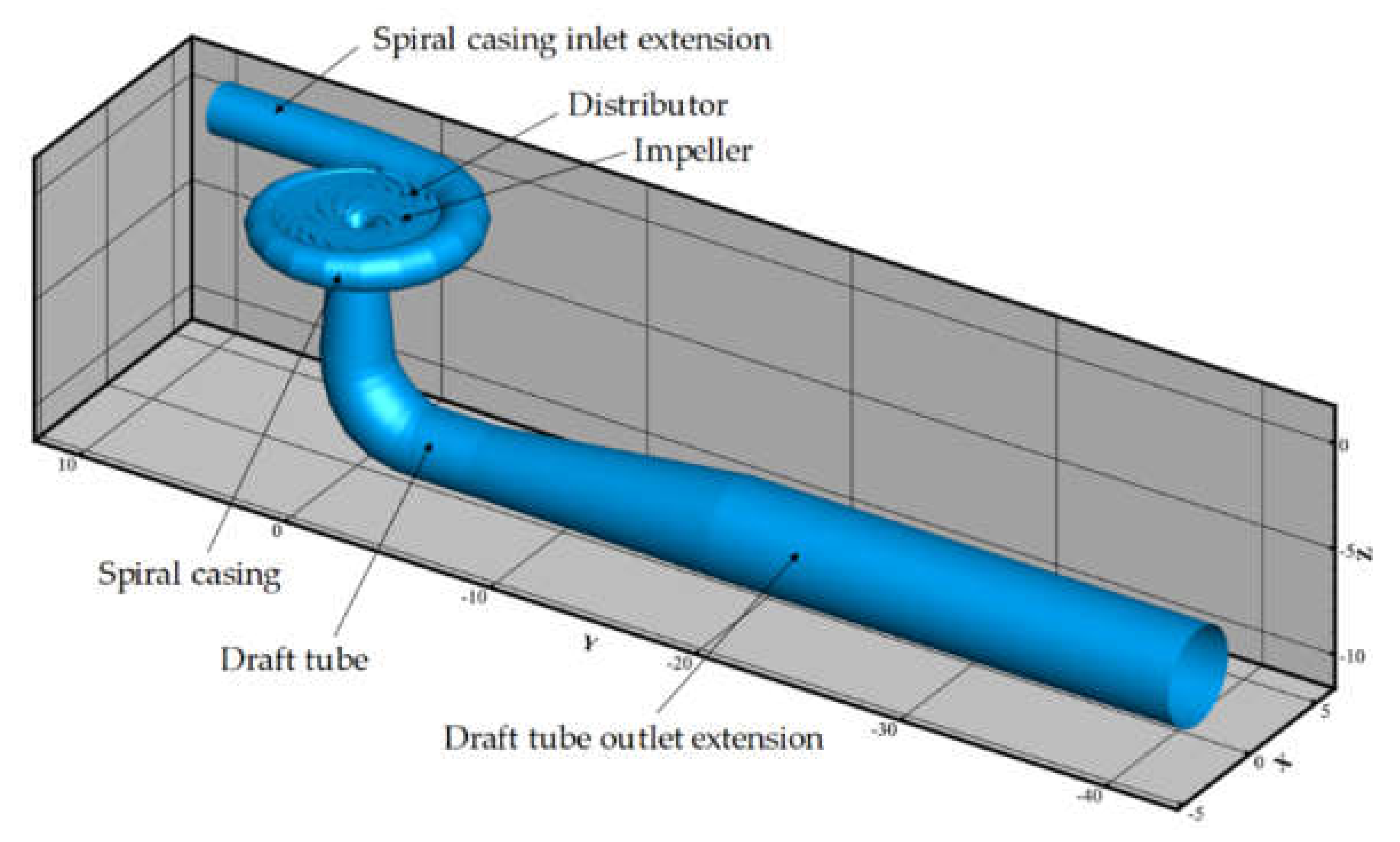

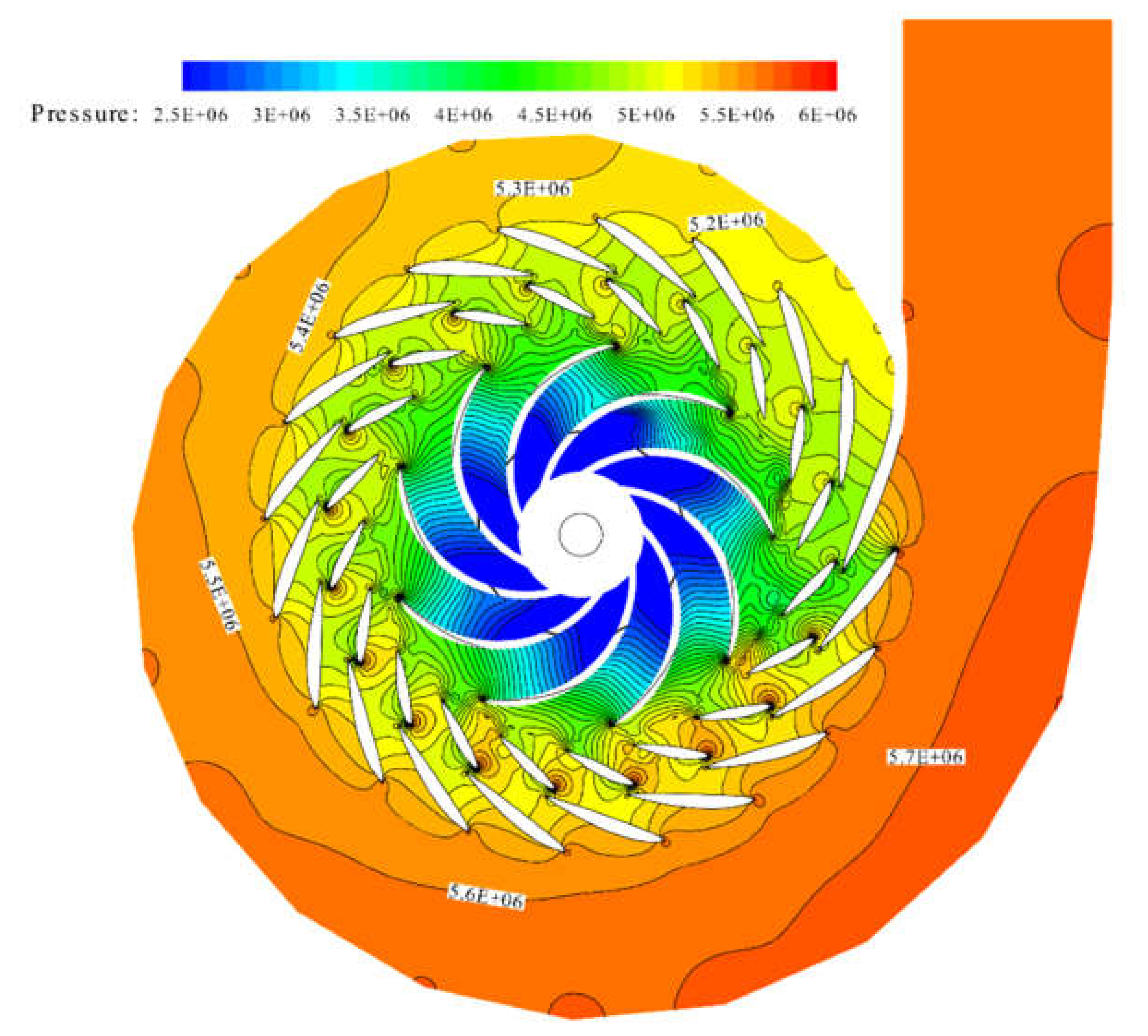




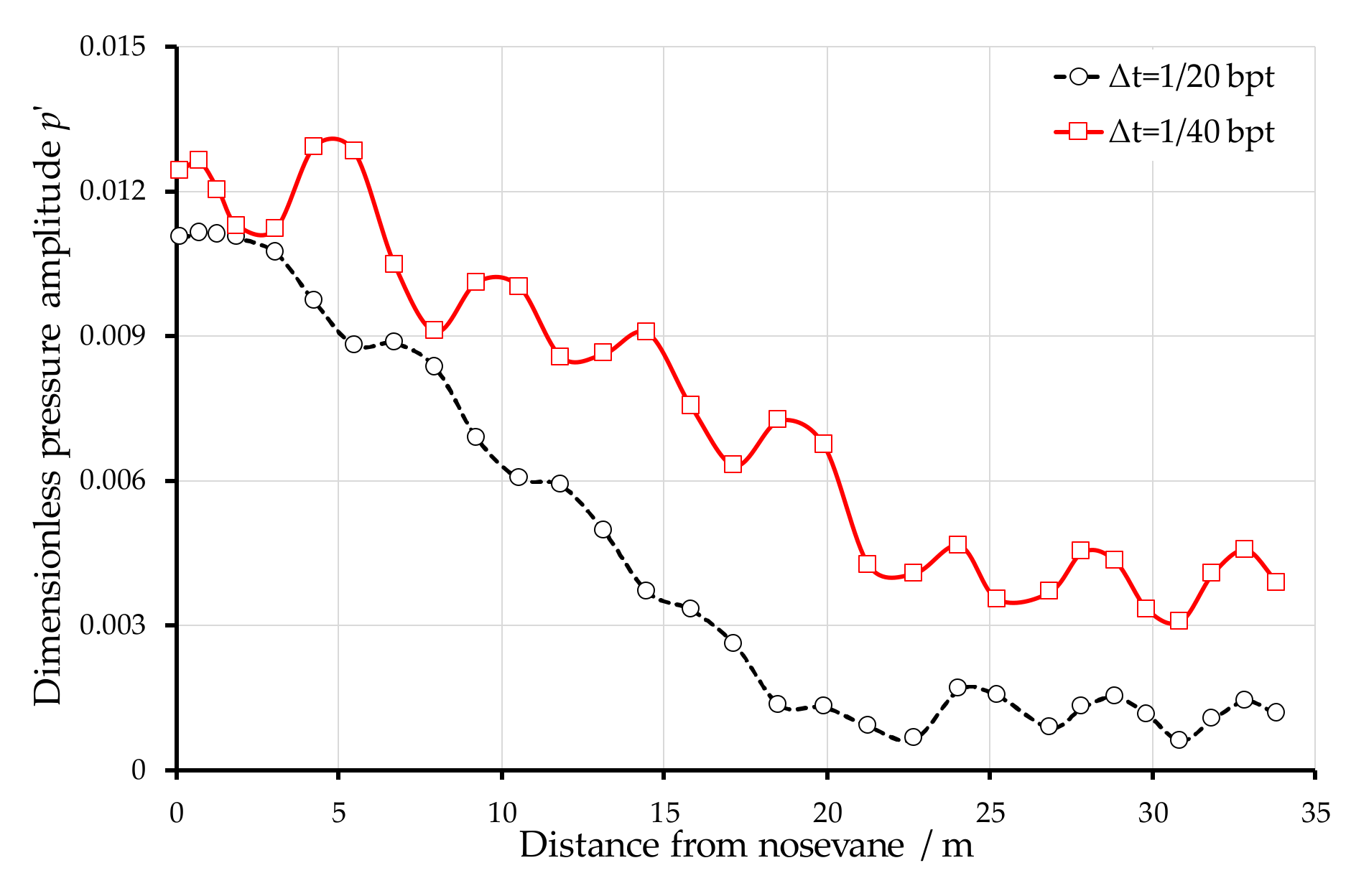
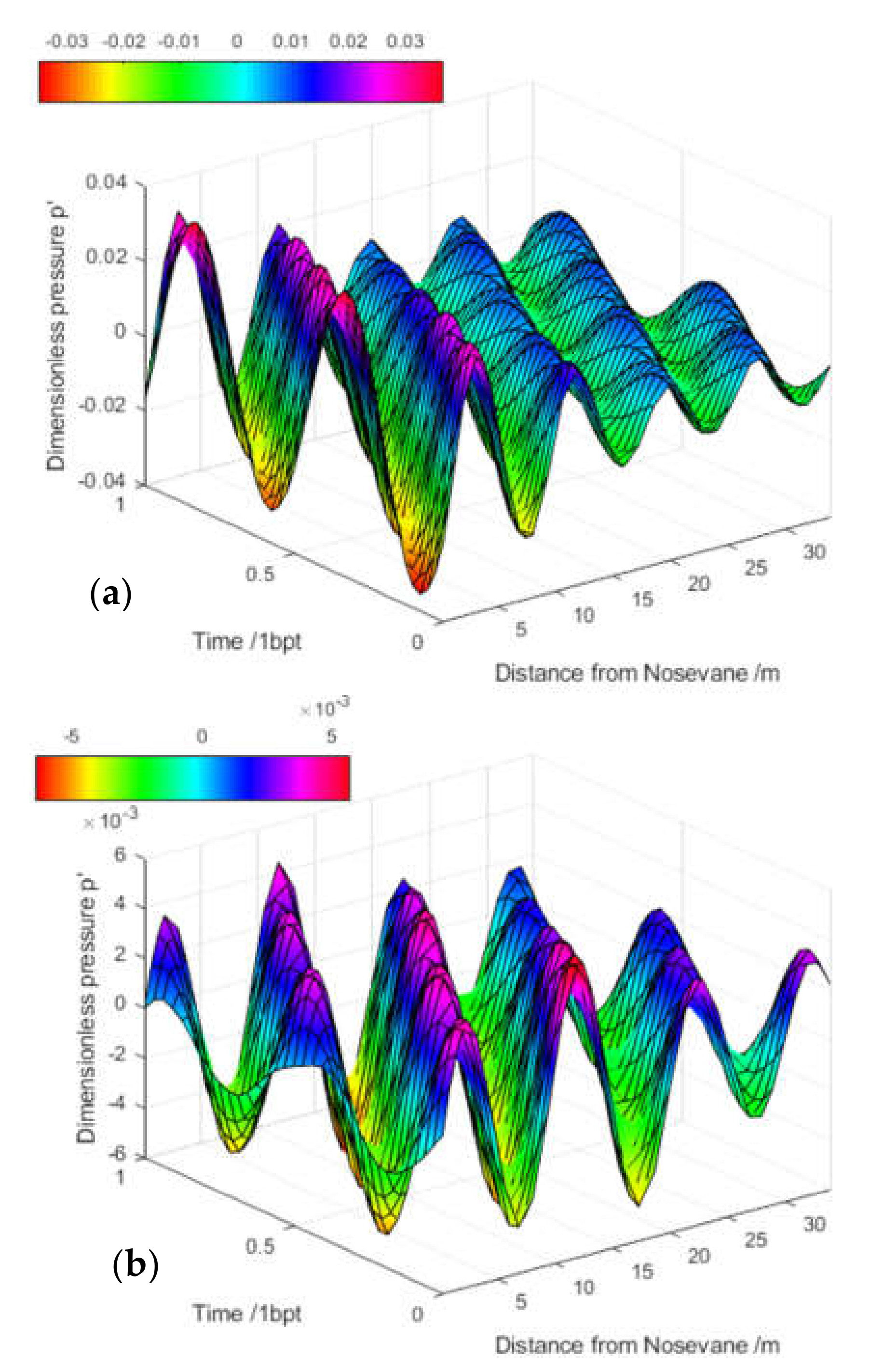

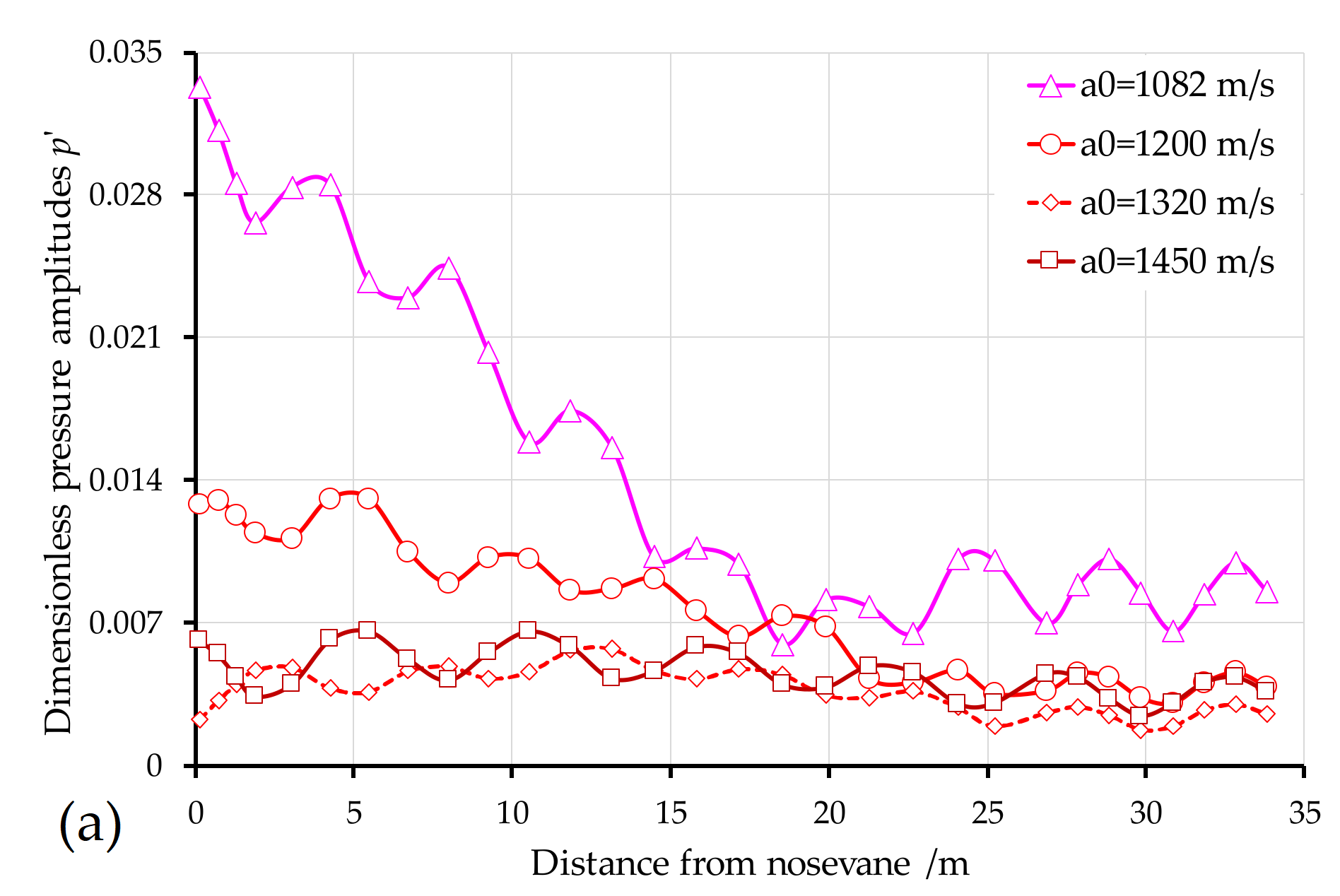
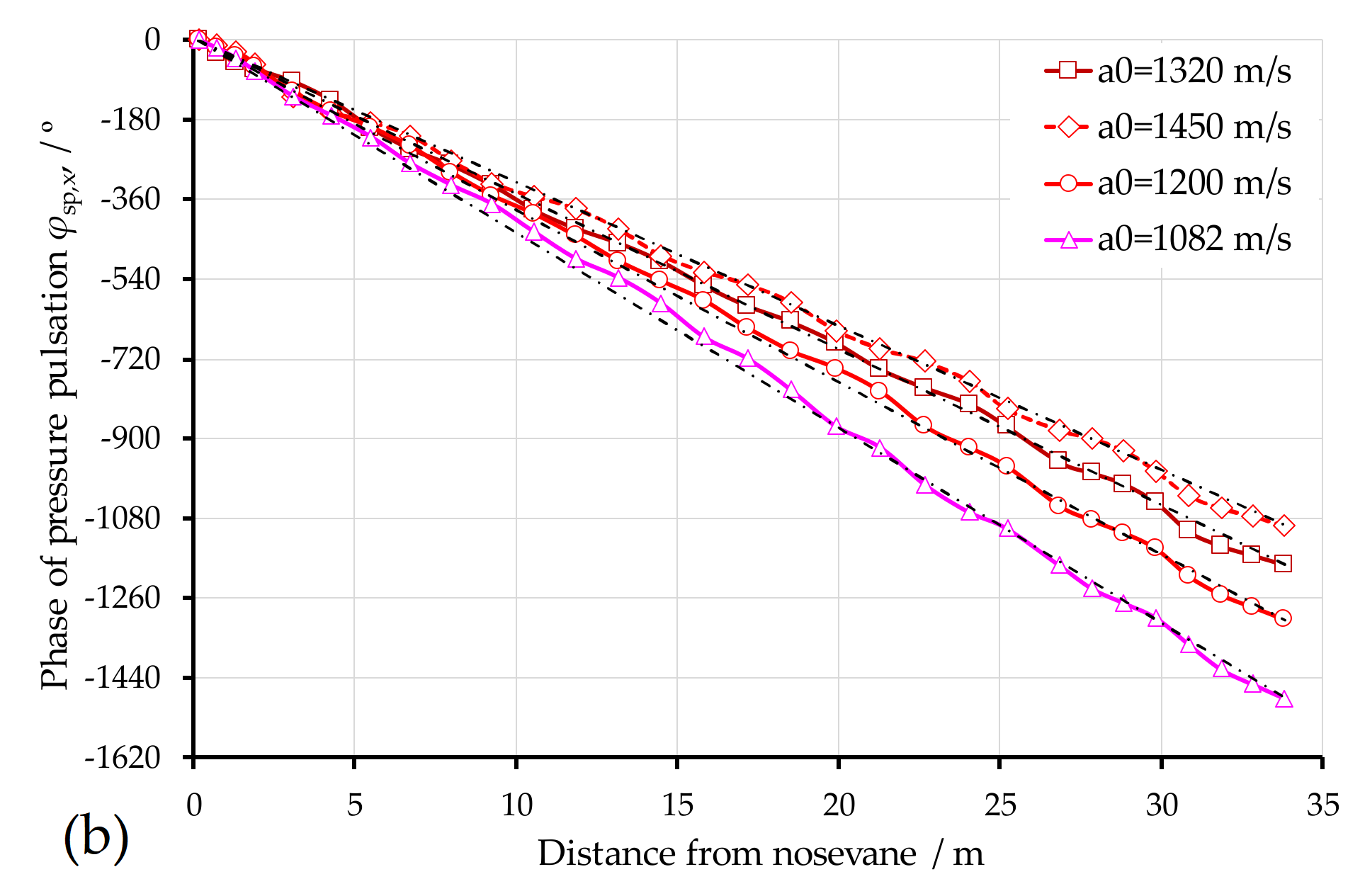
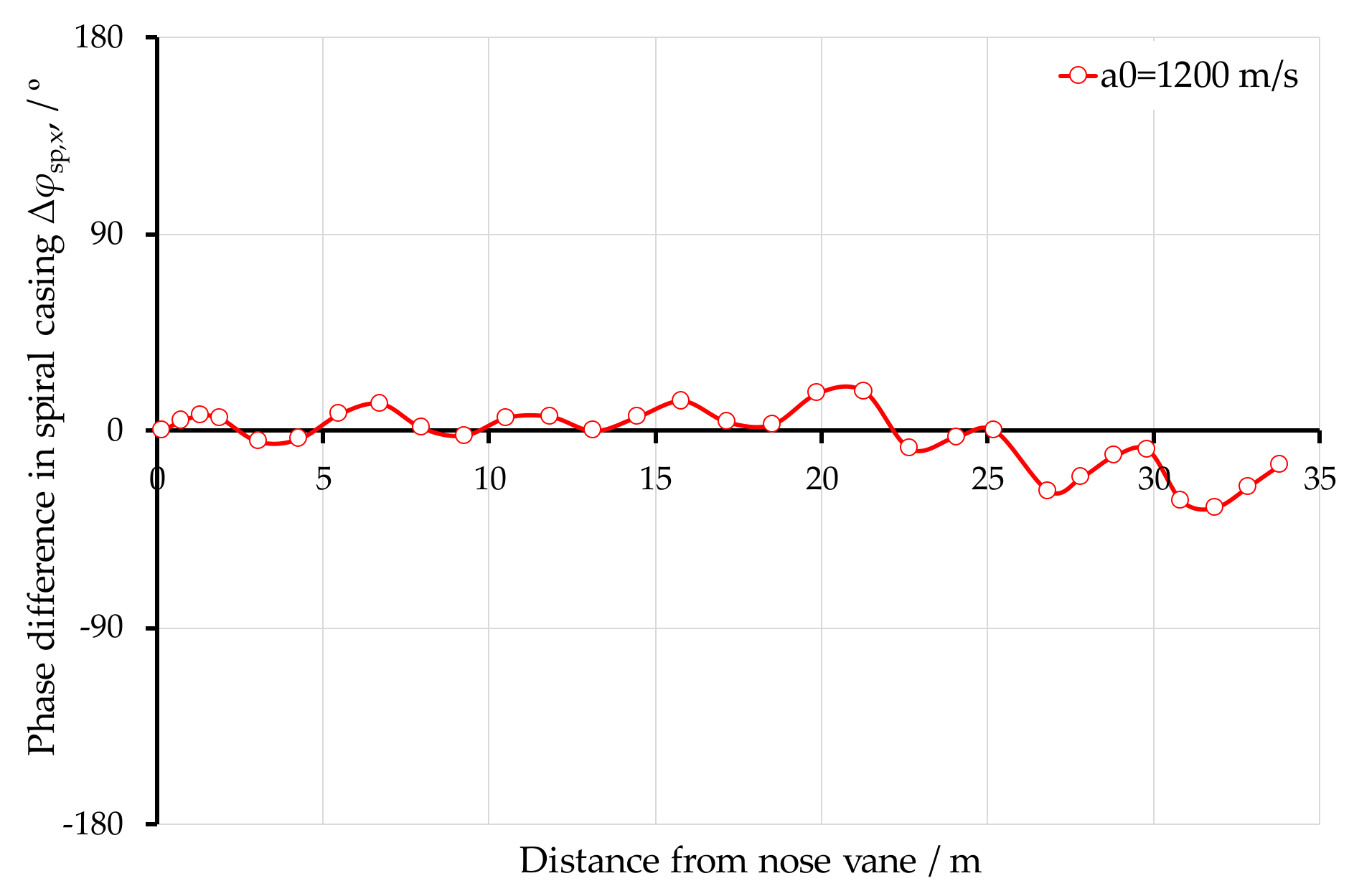


| Symbol | Value | Short Description |
|---|---|---|
| Hr | 419 m | Rated head in turbine mode |
| Qr | 81.52 m3/s | Rated discharge |
| Hs | 70 m | Plant suction head |
| D1a | 4.21 m | Impeller inlet diameter in turbine mode |
| n | 428.6 rev/min | Rated speed |
| Dd | 2.3 m | Diameter of spiral case inlet |
| Ds | 4.5 m | Diameter of draft tube outlet |
| Z2 | 9 | Number of impeller blades |
| Z0 | 20 | Number of guide vanes |
| Lsp | 25.2 m | Circumferential length of the spiral casing (centerline) |
| Δγrat | 29.65° | Rated guide vane opening |
| Components | Number of Nodes | Mesh Software | Mesh Topology |
|---|---|---|---|
| Spiral casing | 1,640,661 | ICEM | Structured |
| Stay Vanes | 1,522,197 | ||
| Guide Vanes | 1,059,480 | TurboGrid | |
| Impeller | 2,432,646 | ||
| Draft tube | 4,782,480 | ICEM |
| Sound speed a0 (m/s) | 1082 | 1200 | 1320 | 1450 |
| Frequency of interest f (Hz) | 128.6 | |||
| Wave length λ (m) | 8.41 | 9.33 | 10.27 | 11.28 |
| Characteristic length of the spiral casing Lsp (m) | 25.2 | |||
| Ratio Lsp/(2λ) | 1.5 | 1.4 | 1.2 | 1.1 |
Publisher’s Note: MDPI stays neutral with regard to jurisdictional claims in published maps and institutional affiliations. |
© 2021 by the authors. Licensee MDPI, Basel, Switzerland. This article is an open access article distributed under the terms and conditions of the Creative Commons Attribution (CC BY) license (https://creativecommons.org/licenses/by/4.0/).
Share and Cite
Fang, Y.; Huang, P.; Jin, S.; Liu, D.; Zhang, J.; Yuan, S. 3D CFD Simulation of Phase Resonance in a Pump Turbine with an Acoustic Model. Energies 2021, 14, 7539. https://doi.org/10.3390/en14227539
Fang Y, Huang P, Jin S, Liu D, Zhang J, Yuan S. 3D CFD Simulation of Phase Resonance in a Pump Turbine with an Acoustic Model. Energies. 2021; 14(22):7539. https://doi.org/10.3390/en14227539
Chicago/Turabian StyleFang, Yujian, Ping Huang, Shibing Jin, Demin Liu, Jinfeng Zhang, and Shouqi Yuan. 2021. "3D CFD Simulation of Phase Resonance in a Pump Turbine with an Acoustic Model" Energies 14, no. 22: 7539. https://doi.org/10.3390/en14227539
APA StyleFang, Y., Huang, P., Jin, S., Liu, D., Zhang, J., & Yuan, S. (2021). 3D CFD Simulation of Phase Resonance in a Pump Turbine with an Acoustic Model. Energies, 14(22), 7539. https://doi.org/10.3390/en14227539






